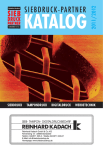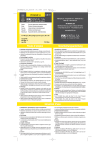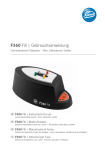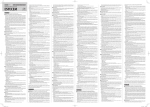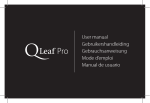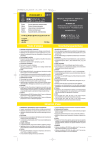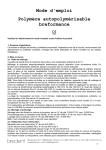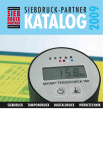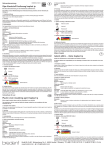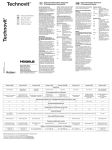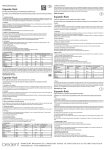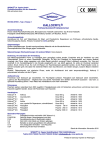Download breformance LiquidColdCuring breformance LiquidColdCuring
Transcript
Gebrauchsanweisung breformance LiquidColdCuring D Bitte diese Gebrauchsanweisung vor dem Produkteinsatz ausführlich lesen! Für Schäden, die durch Nichtbeachten dieser Gebrauchsanweisung entstehen, lehnt der Hersteller jede Haftung ab. 1. Einsatzbereich breformance LiquidColdCuring ist eine Anmischflüssigkeit zur Anwendung von breformance als Kaltpolymerisat. So entsteht ein anminfreier und damit farbstabiler Kunststoff zur Herstellung von provisorischen Kronen und Brücken. 2. Indikation Provisorische Kronen und Brücken, Langzeitprovisorien bis 6 Monate Tragezeit, Reparaturen außerhalb des Mundes, Abdecken von Geschieben bei kombiniertem Zahnersatz, Befestigen von ausgeschliffenen Kunststoff-Prothesen-Zähnen auf Modellgussprothesen. 3. Gefahren- und Sicherheitshinweise breformance LiquidColdCuring ist leicht entzündlich und enthält Methylmethacrylat, Ethandiol- 1, 2-dimethacrylat N,N-Dimethyl-p-toluidin. Darf nicht in die Hände von Kindern gelangen. Kontakt mit den Augen und der Haut vermeiden. Dampf nicht einatmen. R-Sätze: R 11 leichtentzündlich R 20/21/22 Gesundheitsschädlich beim Einatmen, Verschlucken und Berührung von Haut R 33 Gefahr kumulativer Wirkungen R 37/38 Reizt die Atmungsorgane und die Haut R 43 Sensibilisierung durch Hautkontakt möglich S-Sätze: S2 Darf nicht in die Hände von Kindern gelangen S9 Behälter an einem gut gelüfteten Ort aufbewahren S 16 Von Zündquellen fernhalten, nicht rauchen S 36/37 Bei der Arbeit geeignete Schutzhandschuhe und Schutzkleidung tragen S 60 Dieses Produkt und sein Behälter sind als gefährlicher Abfall zu entsorgen 3.1 Verwendete Symbole Xn, gesundheitsschädlich F, leichtentzündlich 4. Lagerungs- und Haltbarkeitshinweise breformance ColdCuringPolymer ist bei Raumtemperatur (23° C) dunkel zu lagern. Vor direkter Sonneneinstrahlung und Hitze schützen. Haltbarkeitsdatum auf dem Etikett beachten. 5. Verarbeitung 5.1 Anmischverhältnis 4 Tropfen Flüssigkeit auf 0,2 Gramm Pulver bei 23° C Raumtemperatur. breformance LiquidColdCuring flüssig anmischen. Entsprechend der Raumtemperatur einen etwas mehr oder geringeren Anteil an Flüssigkeit in das Pulver einmischen. Bitte beachten: breformance LiquidColdCuring enthält Methylmethacrylat. Reizt Augen, Haut und Atmungsorgane. Berührung mit der Haut vermeiden, da Sensibilisierung möglich. Unter Absaugung arbeiten. breformance LiquidColdCuring ist nur für die Verarbeitung außerhalb des Mundes vorgesehen. Nach gleichmäßigem Anmischen zu einer sahnigen Konsistenz ca. 1 Minute quellen lassen, das Material ist dann verarbeitungsbereit. Bitte beachten: Blasen oder Schlieren im Material werden durch ein korrektes Anmischverhältnis und durch Aufnahme des Materials vom Boden des Anmischbechers vermieden. Materialbehälter nach Entnahme verschließen. Gipsmodell, vor dem Anmischen des Autopolymerisats, mit breformance Insulating Liquid/Isoplast ip 750 ml (REF 540 0101 9) dünn bestreichen. Vor dem Befestigen des Silikonschlüssels (haptosil D REF 540 0118 0) schwer zugängliche Bereiche mit breformance LiquidColdCuring benetzen, um ein leichteres Einfließen der angemischten Masse in diesen Bereichen zu ermöglichen. Die Verarbeitungsbreite beträgt ca. 3 bis 5 Minuten, abhängig von der Raumtemperatur. Die Polymerisation an der Luft beträgt ca. 10 Minuten. Schnellere und blasenfreie Aushärtung wird durch Einsatz eines Druckpolymerisationstopfes (3 bis 4 bar, Wassertemperatur 40° C, 5 Minuten) unterstützt. Wird der Aufbau der Restauration in mehreren Polymerisationsschritten durchgeführt, ist ein Beschleifen und anschließendes Benetzen der Oberfläche mit breformance LiquidColdCuring (Pinsel), vor der Ergänzung erforderlich. 5.2 Beschleifen und Polieren Beschleifen mit Hartmetallfräsern, (z. B. REF D194 KT 23, max. 15.000 U/Min.) Vorpolieren mit Rundbürste Rodeo, (REF 350 0096 0, Ø 18 mm, max.15.000 U/Min.) Hochglanzpolitur mit Baumwollschwabbel (REF 350 0065 0, max. 15.000 U/Min.) Bitte beachten: Es wird empfohlen, Schleif- und Polierarbeiten unter einer Absaugung durchzuführen. 5.3 Herstellung einer individuellen Restauration Wax-up mit biotec-Wachs grau, (REF 510 0061 0) Silikonschlüssel aus haptosil D, (REF 540 0118 0) Stumpflack lichthärtend opak rot, (REF 540 0010 4) Auf der Zahnform aus Dentin den Verlauf des Schmelzbereichs markieren und anschließend mit einem Hartmetallfräser, für die Aufnahme von Transparenz/Schneidemasse, reduzieren. Für spezielle Effekte bei der Individualisierung haben sich Pulver von Keramikmalfarben, eingemischt in Schmelz- oder Transparentmasse, bewährt. 6. Zuordnung von Cervical und Enamel - Massen zu Dentinmassen Cervical 1 Cervical 2 A2/A3/B3/C3 A3,5/D3 Enamel 1 Enamel 2 A2/A3/B3/C2 A3,5/D3 7. Sonstige Hinweise Diese Gebrauchsanweisung entspricht dem aktuellen Stand der Technik und unseren eigenen Erfahrungen. Das Produkt darf nur in der unter Punkt 2 beschriebenen Indikation verwendet werden. Der Anwender ist für den Einsatz des Produktes selbst verantwortlich. Für fehlerhafte Ergebnisse wird nicht gehaftet, da der Hersteller keinen Einfluss auf die Verarbeitung hat. Eventuell dennoch auftretende Schadenersatzansprüche beziehen sich ausschließlich auf den Warenwert unserer Produkte. Instructions for use breformance LiquidColdCuring GB Before using the product, please read these instructions for use carefully! The manufacturer will not accept any liability for damage resulting from non-compliance with these instructions for use. 1. Indication range breformance LiquidColdCuring is a mixing liquid for the use of breformance as a cold-curing resin. An amine-free and hence color-stable resin is obtained for the fabrication of temporary crowns and bridges. 2. Indication Temporary crowns and bridges, long-term temporary restorations to be worn over a period of up to 6 months, extraoral (indirect) repairs, covering attachments in combined dentures, fixation of milled acrylic denture teeth on CoCr dentures. 3. Safety recommendations and hazard warnings breformance LiquidColdCuring is highly flammable and contains methyl methacrylate, ethanediol-, 1,2 dimethacrylate N,N-dimethyl-p-toluidine. Keep out of children‘s reach. Avoid contact with eyes and skin. Do not inhale vapors. R-codes: R 11 Highly flammable R 20/21/22 Harmful by inhalation, in contact with skin and if swallowed R 33 Danger of cumulative effects R 37/38 Irritating to respiratory system and skin R 43 May cause sensitization by skin contact S-codes: S2 Keep out of children‘s reach S9 Keep container in a well-ventilated place S 16 Keep away from sources of ignition - no smoking S 36/37 Wear suitable protective clothing and gloves S 60 This material and its container must be disposed of as hazardous waste 3.1 Symbols Xn, hazardous to health F, highly flammable 4. Storage and durability information breformance LiquidColdCuring must be stored at a dark place at room temperature (23 °C). Protect against direct sunlight and heat. Observe the expiration date on the label. 5. Processing 5.1. Mixing ratio Add 4 drops of liquid to 0.2 g of powder at a room temperature of 23° C. Mix breformance LiquidColdCuring to obtain a liquid consistency. Add a larger or small quantity of liquid into the powder depending on the room temperature. Please note: breformance LiquidColdCuring Liquid contains methyl methacrylate. Irritates eyes, skin and respiratory organs. Product must not come into contact with skin to avoid possible sensitization. Work under an extraction system. breformance LiquidColdCuring is exclusively intended to be used for extraoral processing. After powder and liquid have been mixed evenly to obtain a creamy consistency, allow the material to swell approx. 1 minute; afterwards the material is ready for processing. Please note: Bubbles or flowmarks in the material can be avoided by ensuring a correct mixing ratio and by avoiding the adherence of any material to the bottom of the mixing cup. The material container must be sealed after taking out some material. Apply a thin coat of breformance Insulating Liquid/Isoplast ip 750 ml (REF 540 0101 9) onto the plaster model before mixing the self-curing (autopolymerizing) resin. Prior to fixing the silicone key (haptosil D REF 540 0118 0)), apply breformance LiquidColdCuring Liquid to areas that are difficult to access to allow that the mixed material flows more easily into these areas. The processing time span is approx. 3 to 5 minutes depending on the room temperature. The time for polymerizing at air is approx. 10 minutes. Faster and bubble-free curing is achieved by the use of a pressure polymerization pot (3 to 4 bar, water temperature of 40° C, 5 minutes). If the restoration is built up using several polymerization steps, grinding and wetting of the surface with breformance LiquidColdCuring (brush) is required before adding any additional material (porcelain). 5.2. Grinding and polishing Grinding with tungsten carbide burs, (e.g. REF D194 KT 23, max. 15,000 rpm) Prepolishing with Rodeo round brush, (REF 350 0096 0, Ø 18 mm, max.15,000 rpm) High luster polishing with cotton buff, (REF 350 0065 0, max. 15,000 rpm) Please note: It is recommended to perform grinding and polishing work under an extraction system. 5.3. Fabrication of an individual restoration Wax-up with biotec wax, grey, (REF 510 0061 0) Silicone key produced with haptosil D, (REF 540 0118 0) Light-curing die varnish, opaque, red, (REF 540 0010 4) Mark the line of the enamel area on the dentine tooth mould and cut back using a tungsten carbide bur for the application of transparent/incisal material. Powders of ceramic stains mixed with enamel or transparent materials (porcelains) have proved to be useful to achieve special effects when individualizing restorations. 6. Appropriation of cervical and enamel materials to dentine materials Cervical 1 Cervical 2 A2/A3/B3/C3 A 3,5/D3 Enamel 1 Enamel 2 A2/A3/B3/C2 A3,5/D3 7. Additional information These instructions for use are based on state-of-the-art methods and equipment and our own experience. The product may only be used for the indication described under item 2. The user himself is responsible for processing the product. Liability for incorrect results shall be excluded since the manufacturer does not have any influence on further processing. Any occurring claims for damages may only be made up to the value of our products. Mode d'emploi breformance LiquidColdCuring F Veuillez lire attentivement le mode d’emploi avant d’utiliser le produit. Le fabricant décline toute responsabilité pour tout dommage qui résulterait de la non observation de ce mode d’emploi. 1. Domaine d’application breformance LiquidColdCuring est un liquide de mélange servant à l’emploi de breformance en tant que polymère à froid. Il permet de réaliser une résine exempte d’amines et en conséquence de teinte stable pour la confection de couronnes et bridges provisoires. 2. Indications Couronnes et bridges provisoires, prothèses temporaires pouvant être portées jusqu’à 6 mois, réparations hors de la bouche, recouvrement des attachements en prothèse combinée, fixation de dents artificielles en résine meulée sur des châssis métalliques. 3. Consignes de sécurité et identification des dangers breformance LiquidColdCuring est facilement inflammable et contient du méthacrylate de méthyle, de l’éthandiol-1, 2- diméthacrylate N,N-diméthyl-p-toluidine. Il est à conserver hors de la portée des enfants. Eviter tout contact avec les yeux et la peau. Ne pas respirer les vapeurs. Phrases R (de risques): R 11 Facilement inflammable R 20/21/22 Nocif par inhalation, par ingestion et contact avec la peau R 33 Danger d’effets cumulatifs R 37/38 Irritant pour les voies respiratoires et la peau R 43 Peut entraîner une sensibilisation par contact avec la peau Phrases S (de prudence) : S2 Conserver hors de la portée des enfants S9 Conserver le récipient dans un endroit bien ventilé S 16 Conserver à l’écart de toute flamme ou source d’étincelles. Na pas fumer. S 36/37 Porter un vêtement de protection et des gants appropriés. S 60 Eliminer le produit et son récipient comme un déchet dangereux. 3.1 Symboles utilisés Xn, nuisible à la santé F, facilement inflammable 4. Consignes de stockage et date de péremption Stocker breformance LiquidColdCuring à température ambiante (23° c) et à l’abri de la lumière. Protéger le produit contre une exposition directe aux rayons du soleils et contre la chaleur. Veuillez observer la date de péremption sur l’étiquette. Weissenhorner Str. 2 · 89250 Senden · Germany · Tel. (+49) 0 73 09 / 8 72-22 · Fax (+49) 0 73 09 / 8 72-24 www.bredent.com · e-mail [email protected] 6. Classement des masses cervicales et émail par rapports aux masses dentine Cervical 1 Cervical 2 A2/A3/B3/C3 A 3,5/D3 Enamel 1 Enamel 2 A2/A3/B3/C2 A3,5/D3 7. Divers Ce mode d’emploi est basé sur les connaissances techniques actuelles et sur nos propres expériences. Le produit doit uniquement être utilisé selon l’indication décrite au paragraphe 2. L’utilisateur est lui-même responsable de l’utilisation du produit. N’ayant aucune influence sur sa mise en œuvre, le fabricant ne saurait être tenu responsable de résultats défectueux ou non satisfaisants. Toute indemnisation éventuelle se limitera à la valeur du produit. Istruzioni per l‘uso breformance LiquidColdCuring I Leggere attentamente le istruzioni prima dell’utilizzo del prodotto. Il produttore non si assume alcuna responsabilità per danni, dovuti all’inosservanza delle presenti istruzioni d’uso. 1. Campo d’applicazione breformance LiquidColdCuring è un liquido da miscelazione per l’utilizzo della resina breformance come resina a freddo. In tal modo si ottiene una resina priva di ammina terziaria e pertanto con maggiore stabilità del colore per la realizzazione di ponti e corone provvisori. 2. Indicazioni Ponti e corone provvisori, provvisori di lunga durata (permanenza nel cavo orale fino a 6 mesi), riparazioni al di fuori del cavo orale, rivestimento degli attacchi su protesi combinata, modifica di denti preconfezionati su protesi scheletrica. 3. Avvertenze sui pericoli e per la sicurezza breformance LiquidColdCuring è facilmente infiammabile e contiene Metilmetacrilato, Etandiolo 1,2 Dimetacrilato N,N-Dimetil-p-toluidina. Conservare fuori dalla portata dei bambini. Evitare il contatto con gli occhi e con la pelle. Non inalare i vapori. Frasi R: R 11 Facilmente infiammabile R 20/21/22 Nocivo per inalazione, contatto con la pelle e per ingestione R 33 Pericolo di effetti cumulativi R 37/38 Irritante per le vie respiratorie e la pelle R 43 Può provocare sensibilizzazione in caso di contatto con la pelle Frasi S: S2 Conservare fuori dalla portata dei bambini S9 Conservare il contenitore in un luogo ben aerato S 16 Conservare lontano da fiamme e scintille, non fumare S 36/37 Indossare indumenti e guanti protettivi S 60 Questo prodotto ed il suo contenitore devono essere smaltiti come rifiuti pericolosi 3.1 Simboli utilizzati Xn, nocivo F, facilmente infiammabile 4. Avvertenze di conservazione e durata Conservare breformance LiquidColdCuring al buio ed a temperatura ambiente (23° C). Proteggere dalla luce diretta del sole e da fonti di calore. Verificare la data di scadenza sull’etichetta. 5. Lavorazione 5.1 Rapporto di miscelazione 4 gocce di liquido su 0,2 grammi di polvere ad una temperatura ambiente di 23° C. Mescolare il breformance LiquidColdCuring in modo fluido. In base alla temperatura ambiente aggiungere o togliere una parte di liquido rispetto alla polvere. Attenzione: breformance LiquidColdCuring – Liquido contiene metilmetacrilato. Irrita gli occhi, la pelle e le vie respiratorie. Evitare il contatto con la pelle, poiché vi è possibilità di sensibilizzazione. Lavorare con un impianto d’aspirazione. breformance LiquidColdCuring è stato ideato per la lavorazione al di fuori del cavo orale. Dopo aver miscelato in modo omogeneo fino ad ottenere una consistenza cremosa, lasciare riposare 1 minuto, dopodiché il materiale è pronto per essere lavorato. Attenzione: Bolle e striature nel materiale possono essere evitate con una corretta miscelazione e raccogliendo il materiale dal fondo del bicchiere di miscelazione. Richiudere il contenitore subito dopo aver prelevato il prodotto. Stendere uno strato sottile di isolante liquido breformance/Isoplast ip 750 ml (REF 540 0101 9) sul modello in gesso, prima della miscelazione dell’autopolimerizzante. Prima di fissare la mascherina in silicone (Haptosil D REF 540 0118 0) inumidire le zone difficilmente raggiungibili con il liquido breformance LiquidColdCuring, per facilitare la colatura della massa miscelata in tale ambito. Il tempo di lavorazione va da ca. 3 a 5 minuti, in base alla temperatura ambiente. La polimerizzazione all’aria avviene in ca. 10 minuti. Un indurimento più veloce e privo di bolle si ottiene con l’utilizzo di una pentola a pressione (da 3 a 4 bar, temperatura dell’acqua 40° C, per 5 minuti) Se il procedimento di ricostruzione viene eseguito in molteplici fasi, prima di applicare lo strato successivo di materiale, è necessario rifinire ed infine inumidire la superficie con il liquido breformance LiquidColdCuring (pennello). 5.2. Rifinire e lucidare Rifinire con frese in carburo di tungsteno (p. es. REF D194 KT 23, max. 15.000 giri/min). Prelucidare con una spazzola a ruota Rodeo (REF 350 0096 0, Ø 18 mm, max. 15.000 giri/min). Lucidatura a specchio con la spazzola di cotone (REF 350 0065 0, max. 15.000 giri/min). Attenzione: Si consiglia, si eseguire lavori di rifinitura e lucidatura sotto un impianto d’aspirazione. 5.3. Realizzazione di una ricostruzione individuale Wax-up con cera biotec grigia (REF 510 0061 0). Mascherina in silicone Haptosil D (REF 540 0118 0). Lacca per monconi fotoindurente opaca rossa (REF 540 0010 4). Contrassegnare sul dente realizzato in dentina i mammelloni ed infine, con una fresa al carburo di tungsteno, ridurli per l’applicazione di smalto e massa trasparente. Per effetti speciali di caratterizzazione individuale si sono ottenuti ottimi risultati mescolando polvere di supercolori per ceramica con smalto o massa trasparente. 6. Comparazione delle masse cervicali e degli smalti alle masse dentinali Cervical 1 Cervical 2 A2/A3/B3/C3 A 3,5/D3 Enamel 1 Enamel 2 A2/A3/B3/C2 A3,5/D3 7. Ulteriori avvertenze Questi istruzioni d’uso si basano sullo stato attuale della tecnica e su nostre esperienze. Il prodotto deve essere utilizzato solo in base alle indicazioni descritte al punto 2. L’utente è personalmente responsabile dell’utilizzo del prodotto. Il produttore non si assume responsabilità per risultati non conformi, poiché non ha alcuna influenza sulle lavorazioni successive. Nel caso in cui, tuttavia, fosse richiesto un risarcimento dei danni, questo sarà commisurato esclusivamente al valore commerciale dei nostri prodotti. Folleto de instrucciones breformance ColdCuringLíquido E Rogamos lean detenidamente la información de producto ante de su uso. Por daños producidos por no tener en cuenta esta hoja de instrucción, no se hace responsable el fabricante. 1. Campo de uso Breformance ColdCuring es un líquido de mezcla para ser utilizado con breformance como autopolimerizable. Así se crea una resina sin anmin y estable en su color para la creación de puentes y coronas provisionales. 2. Indicaciones Para realizar provisionales de coronas y puentes, provisionales de largo tiempo hasta 6 meses, reparaciones fuera de la boca, para tapar ataches en trabajos combinados, fijación de dientes artificiales retocados sobre esqueléticos. 3. Consejos de seguridad y peligrosidad breformance ColdCuringLíquido es fácilmente inflamable y contiene metilmetacrilato, Ethandiol- 1,2- dimetacrilato N,N-Dimetilo-p-toluidin. Evitar que caiga en manos de los niños. Evitar el contacto con los ojos y piel. No inhalar los vapores. Normas R: R 11 fácil inflamable R20/21/22 Perjudicial al ser inhalado, tragado y en contacto con la piel R33 Peligrosidad acumulada R37/38 Irrita las vías respiratorias y la piel R 43 posible sensibilidad por contacto en la piel! Normas S: S2 Evitar que llegue a manos de los niños S9 Almacenar el envase en un sitio bien ventilado S 16 Mantener alejado de focos de fuego –no fumar! S36/37 Durante su manipulación llevar guantes de protección adecuados, así como ropas. S 60 Este producto y su recipiente eliminar como basura peligrosa 3.1 Símbolos utilizados Xi, irrita F, inflamable 4. Durabilidad y almacenamiento Almacenar breformance ColdCuringLíquido a temperatura ambiental (23° C) en una zona oscura. Proteger de rayos solares directos y calor. Tener en cuenta la fecha de caducidad de la etiqueta. 5. Modo de empleo 5.1. Relación de mezcla 4 gotas de líquido sobre 0,2 gramos de polvo a 23° C de temperatura ambiental. Mezclar el breformance ColdCuringLíquido bastante líquido. Dependiendo de la temperatura de la habitación mezclar toda la cantidad de líquido ó la mitad con el polvo. A tener en cuenta: breformance ColdCuringLíquido contiene metilmetacrilato. Irrita los ojos, piel y vías respiratorias. Evitar el contacto con la piel, ya que pueda haber una sensibilización. Trabajar con aspiración. El breformance ColdCuringLíquido solo se podrá trabajar fuera de boca. Una vez se haya mezclado en una consistencia cremosa dejar aprox. 1 min. reposar, es entonces cuando el material se puede trabajar. A tener en cuenta: la creación de burbujas y estrías se evita mezclando desde la base del recipiente el material y mezclándolo por igual. Una vez se haya terminado cerrar el envase. Pincelar una fina capa sobre el modelo de escayola antes de mezclar la resina autopolimerizable con Insulating Liquid/ Isoplast ip 750 ml REF 540 0101 9. Antes de fijar la llave de silicona (Haptosil REF 540 0118 0) saturar las zonas de difícil acceso con breformance ColdCuringLíquido, para facilitar la fluidez del material mezclado. El tiempo de trabajo es de aprox. 3 hasta 5 minutos, dependiendo de la temperatura ambiental. La polimerización al aire es aprox. 10 minutos Para una polimerización más rápida y sin burbujas se conseguirá introduciendo el trabajo en una olla de presión (3 a 4bar, temperatura de agua 40º C, durante 5 minutos). Si se realizase restauraciones o reconstrucciones de un trabajo en varias veces, se deberá pincelar breformance ColdCuringLíquido antes de cada colocación de resina en la zona, así como dejar la superficie rugosa con la fresa. 5.2. Repasar y pulir Repasar con fresas de tungsteno, por ejemplo, REF D194 KT 23, max. 15.000 rev/min. Prepulido con cepillos de pieza de mano Rodeo, REF 350 0096 0, Ø 18 mm, max.15.000 rev/min. Alto brillo con borrego de algodón REF 350 0065 0, max. 15.000 rev/min. A tener en cuenta: se aconseja realizar el repasado y pulido bajo una aspiración. 5.3. Creación de una restauración individual Wax-up con cera biotec gris, REF 510 0061 0. Llave de silicona de Haptosil, REF 540 0118 0. Espaciador fotopolimerizable opaco rojo, REF 540 0010 4. Marcar sobre el núcleo de dentina el recorrido de donde va a ir la masa incisal y a continuación repasar con una fresa de tungsteno, para reducir así el tiempo de trabajo de colocación de masa transparente/incisal. Para efectos especiales durante la individualización se podrán mezclar polvos de maquillaje de cerámica en la masa de transparente o incisal. 6. Las masas de Cervical y Enamel corresponden a las siguientes dentinas Cervical 1 A2/A3/B3/C3 Enamel 1 A2/A3/B3/C2 Cervical 2 A 3,5/D3 Enamel 2 A3,5/D3 7. Consejos adicionales La información sobre el producto se acoge a los últimos resultados y experiencias sobre el mismo. Por ello aconsejamos antes de su uso leer de nuevo la información sobre el producto. Todos los consejos con respecto a su manipulación se basan en nuestra propia experiencia y solo se podrá ver como información orientativa. Nuestros productos están constantemente a desarrollo. Nos reservamos el derecho de cualquier cambio en su construcción y composición. Weissenhorner Str. 2 · 89250 Senden · Germany · Tel. (+49) 0 73 09 / 8 72-22 · Fax (+49) 0 73 09 / 8 72-24 www.bredent.com · e-mail [email protected] 000007EX-20091016 5. Mise en œuvre 5.1. Ratio de mélange 4 gouttes de liquide dans 0,2 grammes de poudre à une température ambiante de 23° C. Mélanger breformance LiquidColdCuring jusqu‘à obtention d‘une consistance fluide. En fonction de la température ambiante, ajouter à la poudre plus ou moins de liquide. N.B.: breformance LiquidColdCuring contient du méthacrylate de méthyle. Irrite les yeux, la peau et les organes respiratoires. Eviter le contact avec la peau en raison d‘une possible sensibilisation. Travailler sous aspiration. breformance LiquidColdCuring ne doit pas être mis en œuvre dans la bouche. Après l‘avoir bien mélangé jusqu‘à obtention d‘une consistance crémeuse, le laisser gonfler pendant 1 minute environ. Le matériau est ensuite prêt à l‘emploi. N.B.: Pour éviter la formation de bulles ou la contamination du matériau, respecter le ratio de mélange et prélever le matériau en partant du fond du bol. Refermer les récipients aussitôt après usage. Avant de mélanger la résine autopolymérisable, isoler le modèle en plâtre en appliquant au pinceau une fine couche de breformance Insulating Liquid/Isoplast ip 750 ml (REF 540 0101 9). Avant de monter la clé en silicone (haptosil D REF 540 018 0), mouiller les zones d‘accès difficile avec breformance LiquidColdCuring, le matériau mélangé pénètrera ainsi plus facilement dans ces zones. La plage de manipulation est d‘env. 3 à 5 minutes en fonction de la température ambiante. La polymérisation à l‘air libre est de 10 minutes env. Pour une polymérisation plus rapide et sans bulle, nous conseillons l‘emploi d‘une cocotte (3 à 4 bars, température de l‘eau 40° C, 5 minutes). Si la restauration est effectuée en plusieurs étapes de polymérisation, il faut meuler et imprégner la surface avec breformance LiquidColdCuring (pinceau) avant chaque étape. 5.2. Meulage et polissage Meulage avec des fraises en carbure de tungstène, (par ex. REF D194 KT 23, max. 15.000 t/mn). Pré-polissage avec la brossette ronde Rodeo, (REF 350 0096 0, Ø 18 mm, max.15.000 t/mn). Lustrage avec le polissoir coton (REF 350 0065 0, max. 15.000 t/mn). N.B.: Il est conseillé de meuler et de polir sous aspiration. 5.3. Réalisation d‘une restauration personnalisée Maquette avec cire biotec grise, (REF 510 0061 0), Clé en silicone avec haptosil D, (REF 540 0118 0), Vernis à dies photopolymérisable opaque rouge, (REF 540 0010 4). Marquer sur la dent en dentine le tracé de la zone d‘émail puis avec une fraise en carbure de tungstène, pratiquer des réductions pour y monter la masse transparente/incisale. Les poudres colorantes, mélangées à la masse incisale ou transparente, sont efficaces pour caractériser la restauration.


